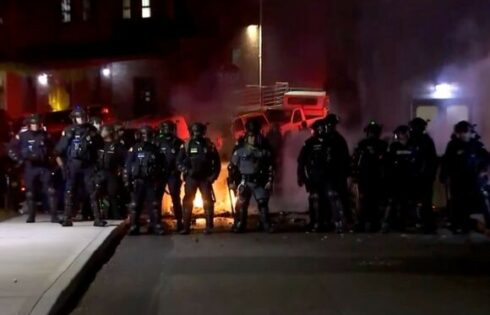
In April 2015, University of Wisconsin star forward Frank Kaminsky was named Associated Press College Basketball Player of the Year. Kaminsky, who had just led the Badgers to two straight Final Four appearances, became the first Wisconsin player to ever receive the award.
In February of 2018, Kaminsky was given the ultimate honor by the school – his number 44 jersey was retired and placed in the rafters, never to be worn by another Badger. In receiving the award, Kaminsky became only the second Wisconsin player to be so honored.
But this week, a local columnist took exception to Kaminsky’s award. Henry Sanders, publisher and CEO of Madison365.com, a publication that aims to “foster dialog between members of diverse communities,” argued in an “open letter” that the school’s honoring of Kaminsky suffers from a significant drawback:
Kaminsky is the wrong color.
“The only two players who’ve been given that honor in the 100-plus years of Badger Men’s Basketball are white,” Sanders notes in the open letter.
“What message do you think that sends to potential recruits and to past and current players of color?” Sanders asks.
“Trust me, they notice,” he adds.
“As a person of color, whenever I go into a building, a business, or a school, I look to see whether or not I’m reflected,” Sanders writes.
“I look at the faces of the people working there. I look at the pictures of the staff on the walls. I look at the people being served. I look to see who’s being celebrated. It’s the little things that tell me where I stand.”
When he’s at a Badger game, Sanders stands in a place that has reserved its loftiest honor for those who earn the game’s highest achievements. By the luck of the draw, those two people happen to be white.
In fact, only seven of the past 30 winners of the national player of the year award have been white – Kaminsky winning the award is an anomaly. One can only imagine the outcry if a white fan decried the lack of “representation” at a school where all the retired jerseys belonged to African-American players.
The other retired jersey, incidentally, belonged to Albert “Ab” Nicholas, a millionaire businessman and former Badger player who donated tens of millions of dollars to the school, including for construction of the Kohl Center, where the team now plays.
Nicholas played for the school in the early 1950s, earning second-team All-American honors. He died in 2016. (Nicholas is mis-identified as “Nichols” in Sanders’ piece, demonstrating that retiring jerseys may not be the best way to keep one’s name fresh in the minds of fans.)
The school only began the practice of retiring jerseys in 2017, when Nicholas was posthumously honored. Kaminsky’s ceremony came a year later – so it is not as if the school has refused to honor black athletes for decades – it just so happens the two most accomplished players in school history, and thus the first two to be honored, were white.
Sanders acknowledges Kaminsky deserves to have his number retired, but complains other black players also deserve the honor, too. He does have a point – Wisconsin has produced a number of NBA players, and the school’s all-time leading scorer, Alando Tucker, is honored only in the record books.
But having to see white people’s names at a basketball game is only one of the microaggressions Sanders cites as evidence the race problem is “endemic” at the UW-Madison.
He mentions the time a math exam included a question about the height of a border wall, a swastika drawn on a dorm door, and the university “dragging its feet” in removing the names of Ku Klux Klan members from a display in the student union (which the school did.)
Sanders further objected to the time in 2016 when campus police showed up in a classroom to arrest a student on a charge of vandalizing school property with graffiti – at the time, campus police said it seemed to be a good time to arrest him because…they knew he would be there.
Keep in mind, of course, that the UW-Madison campus boasts of being one of the most progressive in America. There is no racial equity program the school hasn’t bought into, including setting up a “Hate and Bias” hotline that allows students to anonymously report one another if they hear someone being “biased.”
And the school’s thanks for employing dozens of diversity counselors and funding all these programs? They get to be called racists because the school’s best player has the wrong skin tone.
In fact, a few years ago, the university even sponsored a class called “The Problems of Whiteness.”
Perhaps its next instructor should be Frank Kaminsky.
MORE: University of Wisconsin-Madison readies its new ‘cultural competency’ program
IMAGE: YouTube
Like The College Fix on Facebook / Follow us on Twitter






Please join the conversation about our stories on Facebook, Twitter, Instagram, Reddit, MeWe, Rumble, Gab, Minds and Gettr.